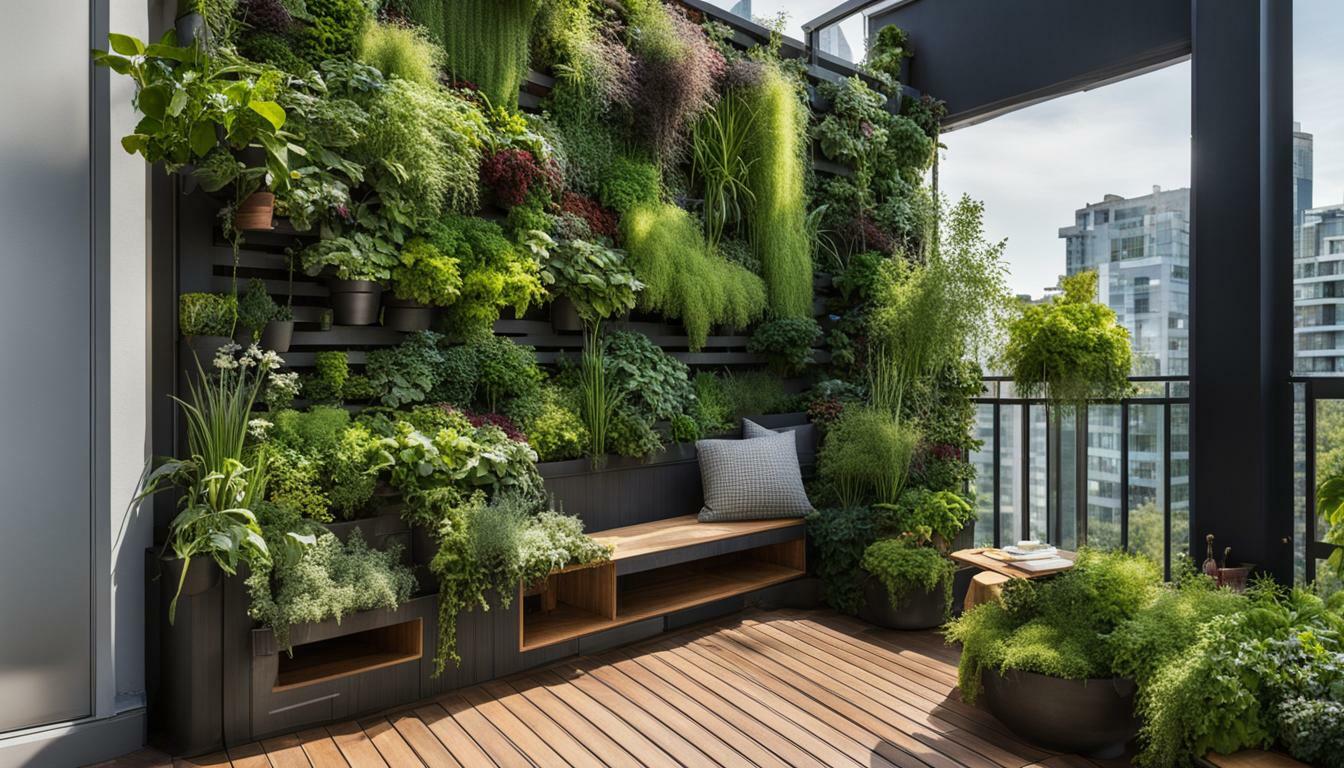Looking to make the most of your outdoor space? Vertical raised garden beds offer a solution that conserves space, increases yield, and transforms your garden aesthetic all in one. With these innovative gardening structures, you can maximize your growing area and create a thriving garden even in limited spaces.
Key Takeaways:
- Starting small with a couple of native plants or easy-to-grow crops is ideal for beginners and saves space.
- Choosing high-yield crops suitable for small gardens, such as carrots, lettuce, and vertically growing crops, maximizes your garden’s potential.
- Vertical gardening allows for optimal yield, better pest management, and easier harvesting.
- Mixing edible and ornamental plants in your garden enhances aesthetics and protects against pests.
- Raised beds provide better soil control, improved crop protection, and efficient use of space in small gardens.
- Investing in multipurpose gardening items, such as hanging bins and benches with extra storage, helps save space.
- Adding a focal point, such as a decorative water feature or cluster of ornamental plants, enhances visual appeal and creates a sense of purpose in a small garden.
- Creating a small seating area with aromatic plants allows for relaxation and enjoyment in the garden.
Start Small
When venturing into gardening, it’s important to start small and select the right plants. By beginning with a few native plants or easy-to-grow crops, you can ease into gardening and ensure success in your small space. Native plants are well-adapted to the local climate, making them easier to take care of, even for busy or newbie gardeners.
Growing a lot of plants can be overwhelming for beginners, so it’s best to curate your collection and start with 3 to 5 plants. This allows you to focus on giving proper care and attention to each plant, ensuring their healthy growth. Easy-to-grow crops like carrots, garlic, lettuce, radishes, and spinach are great choices for small gardens. These crops provide high yields and are suitable for vertical gardening, maximizing your garden’s potential.
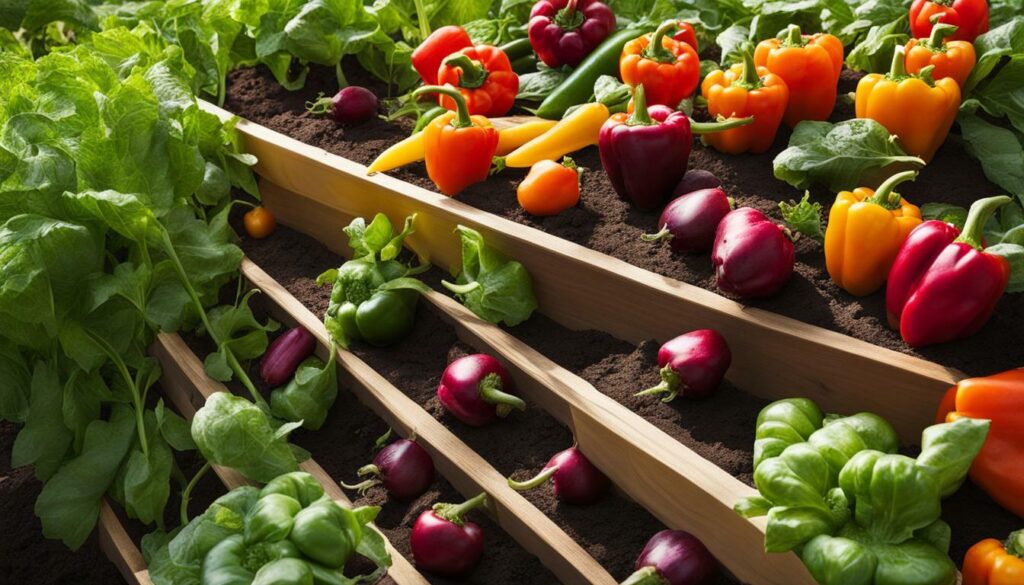
Key Points:
- Start small by selecting a few native plants or easy-to-grow crops
- Native plants are well-adapted to the local climate and easier to care for
- Choose 3 to 5 plants to begin with to avoid being overwhelmed
- Easy-to-grow crops like carrots, garlic, lettuce, and spinach are ideal for small gardens
Choose High Yield Crops
In a small garden, it’s important to choose crops that offer high yields and make the most of limited space. Opt for crops such as carrots, garlic, lettuce, and radishes that thrive in smaller areas and can be grown vertically to optimize your garden’s productivity.
When selecting crops for a small garden, it’s essential to consider their growth habits and space requirements. Avoid planting crops that spread out as they grow, such as cabbages, cauliflower, and broccoli, as they will take up valuable space. Instead, focus on high-yield crops that can be grown in a smaller area.
- Carrots: Carrots are an excellent choice for small gardens as they can be grown vertically and do not require much space. Choose varieties that are suitable for container gardening.
- Garlic: Garlic is a versatile crop that can be grown in small spaces and is known for its high yield. Plant individual cloves in well-draining soil and enjoy a bountiful harvest in a few months.
- Lettuce: Lettuce is a fast-growing crop that can be harvested at different stages of maturity. Plant lettuce varieties suitable for small spaces, and they will provide you with a continuous supply of fresh greens throughout the season.
- Radishes: Radishes are another quick-growing crop that thrives in small gardens. Plant them in succession every few weeks for a continuous harvest.
Vertical gardening is a great way to make the most of limited space and increase your garden’s productivity. By utilizing trellises, bamboo, or netting, you can grow vining crops such as tomatoes, cucumbers, and beans vertically, saving valuable ground space. These crops not only produce high yields but also provide better pest management and easier harvesting.
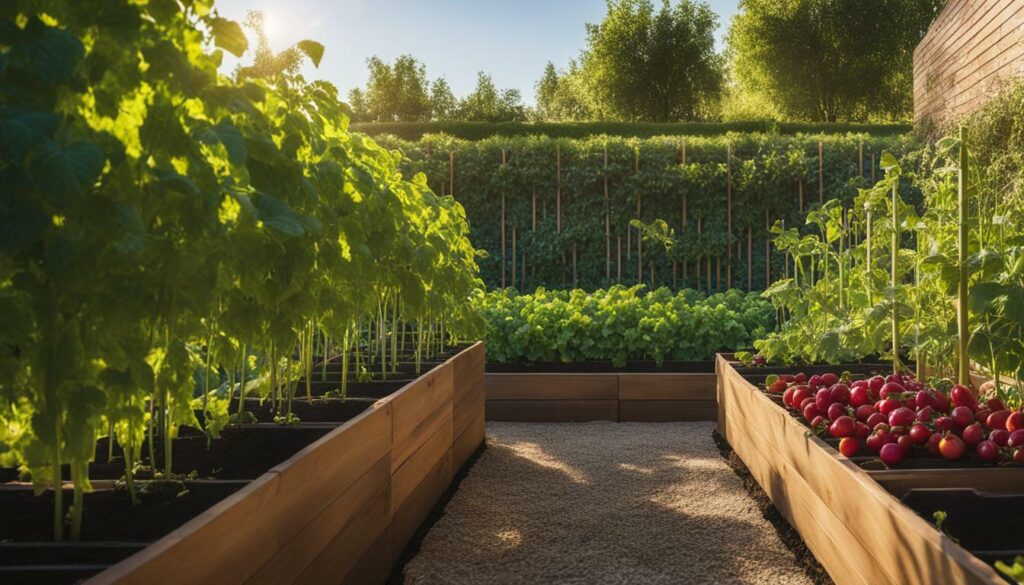
By choosing high-yield crops and utilizing vertical gardening techniques, you can maximize the productivity of your small garden. Don’t be afraid to mix things up and grow a diverse range of edible and ornamental plants to enhance the aesthetics of your space and protect your crops from pests. Consider investing in raised beds to improve soil control and optimize space usage. And don’t forget to create a relaxing seating area where you can unwind and enjoy the fruits of your labor. With these gardening tips, you can turn your small garden into a productive and beautiful oasis.
Table: High Yield Crops for Small Gardens
| Crop | Recommended Varieties |
|---|---|
| Carrots | Atlas, Napoli, Paris Market |
| Garlic | Inchelium Red, Music, German Extra Hardy |
| Lettuce | Bibb, Buttercrunch, Salad Bowl |
| Radishes | Cherry Belle, French Breakfast, Easter Egg |
Try Vertical Gardening
Vertical gardening offers a creative way to maximize space and optimize plant growth. By using trellises, lattice, or other structures, you can create a visually stunning garden that conserves space, enhances yield, and provides better pest management.
The Benefits of Vertical Gardening
Vertical gardening provides numerous benefits for small gardens. First and foremost, it increases the growing area available to gardeners, resulting in higher yields. By utilizing upright growth habits or containers, plants can reach higher levels, reducing the need to bend and kneel for maintenance and harvesting.
Vertical gardening also offers advantages in pest management. With foliage and fruit off the ground, plants are less susceptible to disease. Furthermore, upward growth promotes better air circulation, reducing the risk of moisture-loving fungi and pests. The increased exposure to sunlight can also result in healthier growth.
In addition to practical benefits, vertical gardening is aesthetically pleasing. It adds a unique, three-dimensional dimension to garden layouts, creating a visually stunning display of natural beauty. With the right selection of plants and support systems, you can transform small spaces into vibrant gardens.
Choosing the Right Crops for Vertical Gardening
When selecting crops for vertical gardening, it’s important to choose plants that thrive in upright growth. Vining, rambling, and sprawling plants are ideal candidates for vertical gardens as they can be trained to grow up and off the ground. These plants take up less horizontal space and can be grown on trellises or supports, maximizing the use of vertical space.
Some popular crops for vertical gardening include pole beans, climbing peas, vining tomatoes, and certain types of zucchini, cucumber, melon, and squash. By choosing the right crops, you can ensure a bountiful harvest in limited garden space.
Structures for Vertical Gardening
There are various structures that can be used for vertical gardening, depending on the characteristics of the plants being grown. Trellises, tripods, arches, and pergolas are popular options for supporting vining plants like beans and peas. These structures provide stability and make it easier to manage and harvest the plants.
For more substantial plants like fruit trees, sturdier structures like arches or pergolas may be necessary. It’s important to choose a structure that can accommodate the weight of the mature plants and ensure it is securely anchored to prevent toppling.
| Vertical Garden Structures | Recommended Plants |
|---|---|
| Trellises | Pole beans, climbing peas, vining tomatoes |
| Gazebos, wire cages, netting | Various climbing and vining plants |
| Bamboo poles | Pole beans, sweet peas |
By incorporating vertical gardening techniques and structures, you can transform your small garden into a thriving oasis, maximizing space and enhancing the beauty of your outdoor space.
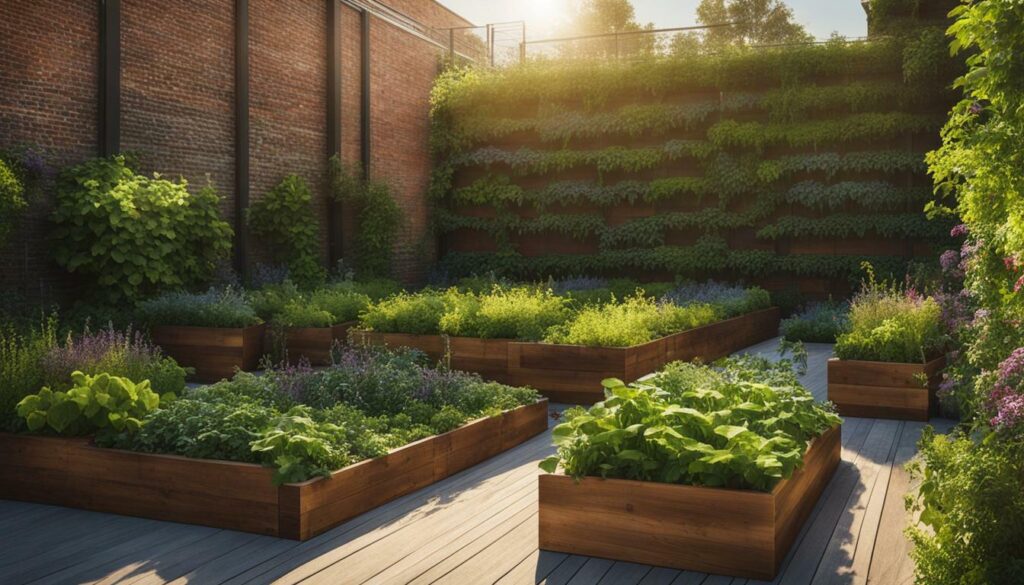
Vertical gardening offers a practical solution for small spaces, allowing you to grow a variety of plants and maximize your garden’s potential. Whether you choose to incorporate trellises, lattice, or other structures, the benefits of vertical gardening are undeniable. From increased yield and better pest management to a visually stunning display, vertical gardening is a game-changer for small space gardening.
Mix Things Up
Break away from traditional gardening practices and mix things up in your small garden by incorporating both edible and ornamental plants. By growing a diverse range of plants, you can enhance the beauty of your garden and protect your crops from pests.
One way to achieve this is by combining edible and ornamental plants in your garden. Not only will this add visual interest and variety to your space, but it can also help deter pests. Certain flowering plants, like nasturtium and calendula, can repel nibbling insects, while others attract pest-eating predators. By planting these alongside your fruit-bearing plants, you can create a natural pest control system.
Another advantage of mixing edible and ornamental plants is that it allows you to maximize your garden space. Traditionally, growers would allocate specific areas for certain types of crops. However, in small gardens, this approach can result in wasted space. By intermixing different types of plants, you can make the most out of your limited garden area and increase your overall yield.
Here is a table showcasing some examples of edible and ornamental plants that can be grown together:
| Edible Plants | Ornamental Plants |
|---|---|
| Tomatoes | Marigolds |
| Peppers | Nasturtiums |
| Herbs (Basil, Parsley, etc.) | Lavender |
| Lettuce | Petunias |
By incorporating a mix of both edible and ornamental plants, you can create a vibrant and dynamic garden space while maximizing your yield and protecting your crops.
Invest in Raised Beds
When gardening in a small space, raised beds are an excellent investment. They provide better control over soil quality, protect crops from diseases and pests, and maximize your use of outdoor space.
Raised beds offer several advantages for gardening in limited spaces. The elevated structure allows for better drainage, preventing waterlogging and enhancing root health. Additionally, you have the flexibility to fill raised beds with high-quality soil, ensuring optimal nutrition for your crops. This is especially beneficial if your garden has poor soil quality.
The confined space of raised beds also helps protect your plants from diseases and pests. By creating a barrier between the soil and the surrounding environment, you can reduce the risk of soil-borne diseases and decrease the likelihood of pests accessing your plants. Raised beds also make it easier to implement protective measures, such as netting or row covers, to further safeguard your crops.
Furthermore, raised beds optimize your use of outdoor space. With traditional row planting, valuable growing area is wasted on walkways. However, raised beds eliminate the need for excessive pathways, allowing you to dedicate more space to planting. This efficient use of space enables you to grow a greater variety of crops, maximizing your garden’s yield.
| Advantages of Raised Beds in Small Gardens |
|---|
| Better control over soil quality |
| Protection against diseases and pests |
| Efficient use of limited space |
Think Multipurpose
To maximize the potential of your small garden, consider incorporating multipurpose gardening items that serve dual functions. Hang bins, benches with extra storage, and patio tables that double as planters can help optimize your space and add functionality to your outdoor area.
One great option is to use hanging bins and baskets. These versatile containers not only provide additional space for growing plants but also serve as storage for gardening tools and supplies. Hang them from fences, walls, or pergolas to make the most of your vertical space.
Another multipurpose item to consider is a bench with extra storage. Look for benches that have built-in compartments or hidden storage space under the seat. This will allow you to store gardening tools, pots, and other essentials, keeping your small garden tidy and organized.
Additionally, patio tables that double as planters are a fantastic way to maximize space in your small garden. These tables feature built-in planters in the center or along the edges, providing a functional and stylish place to enjoy your outdoor space while also adding greenery to your surroundings.
Example of Multipurpose Gardening Items:
| Item | Function |
|---|---|
| Hanging Bins and Baskets | Vertical gardening and storage |
| Bench with Extra Storage | Seating and organization |
| Patio Table with Built-in Planters | Dining and gardening |
By incorporating these multipurpose gardening items into your small garden, you can make the most of limited space while also adding practicality and style to your outdoor area. These items not only optimize space but also provide innovative solutions for storage, seating, and growing plants in a confined environment.
Remember, a small garden doesn’t mean limited possibilities. With the right multipurpose gardening items, you can create a flourishing and functional outdoor space that perfectly suits your needs and preferences.
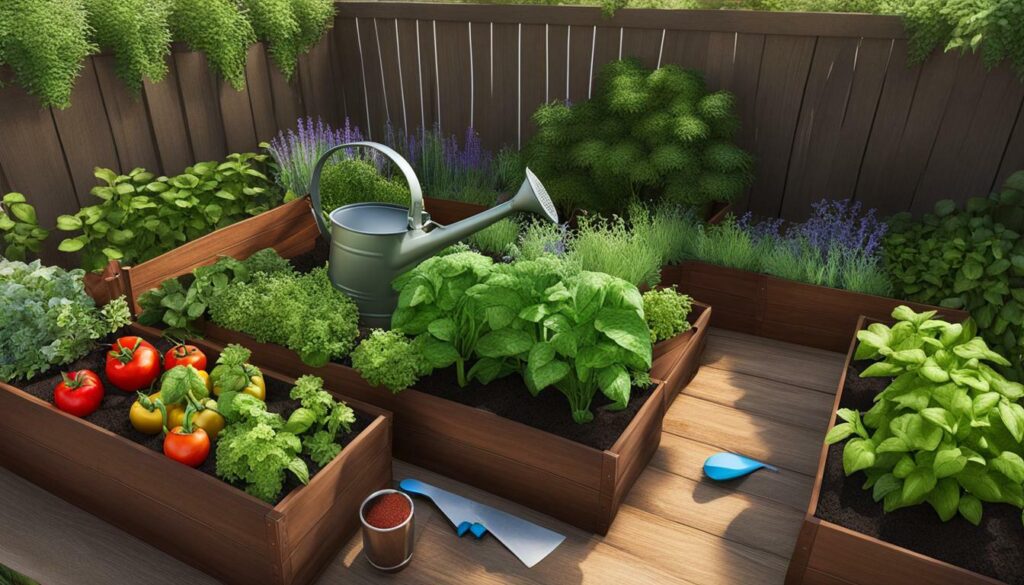
Add a Focal Point
Don’t underestimate the power of a focal point in your small garden. Even in limited spaces, a well-placed decorative water feature, cluster of ornamental plants, or unique hardscape element can serve as a striking focal point that enhances the overall design and creates a purposeful, harmonious space.
Creating a focal point in your garden helps to draw the eye and create visual interest. It can be a centerpiece that adds a sense of direction and intention to the space. Whether it’s a stunning sculpture, a charming bird bath, or a vibrant flower bed, a focal point adds depth and character to your small garden.
One way to create a visual focal point is by using a decorative water feature. The sound of running water adds a soothing ambiance to your garden, while the visual movement creates a dynamic focal point. Consider installing a small fountain or a pond with a cascading waterfall.
If you prefer a more natural focal point, a cluster of ornamental plants can create a beautiful and cohesive display. Choose plants with different heights, textures, and colors to add depth and visual interest. Group them together in an attractive arrangement to create a focal point that catches the eye.
Table: Focal Point Plants
| Plant | Description |
|---|---|
| Lavender | Aromatic flowers with a soothing scent |
| Rosemary | Fragrant herb with delicate blue flowers |
| Hydrangea | Large, colorful blooms that attract butterflies |
| Japanese Maple | Ornamental tree with vibrant foliage |
Remember to position your focal point strategically to create a balanced and visually appealing composition. It should be easily visible and draw the viewer’s attention without overpowering the entire garden.
By incorporating a focal point into your small garden design, you can transform a simple space into a captivating oasis. It adds personality and charm while creating a sense of purpose and direction. Whether you choose a water feature, an arrangement of plants, or a unique hardscape element, a focal point will elevate your small garden to new heights.
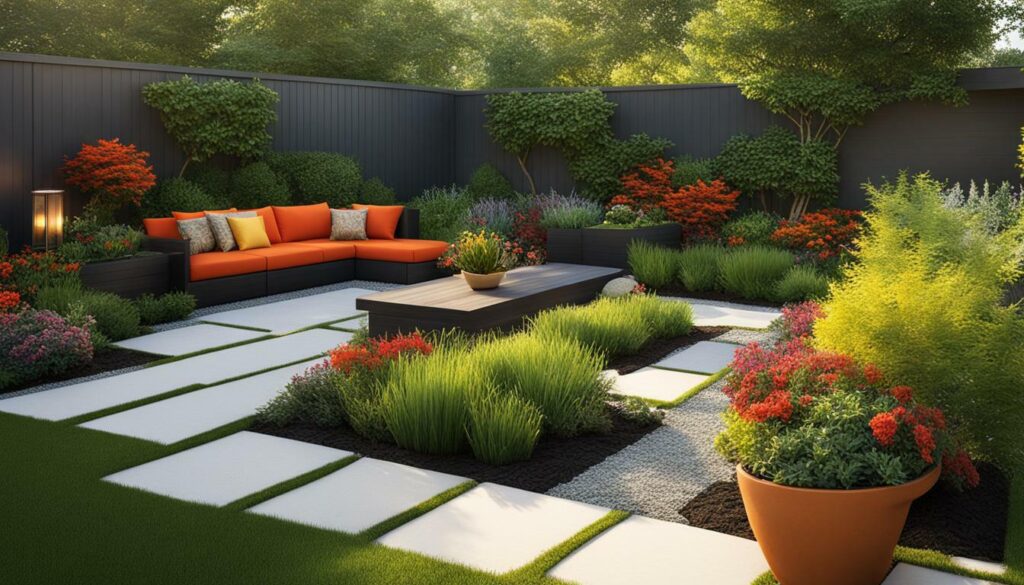
A Place for Relaxing
Even in a small garden, it’s essential to carve out a space for relaxation and enjoyment. By adding a simple seating area, such as a rustic bench or compact patio chairs, surrounded by aromatic herbs and flowering plants, you can create an intimate and soothing spot to unwind in your garden.
Imagine sitting on a comfortable bench, sipping a cup of tea, and being surrounded by the delightful scents of lavender, mint, and rosemary. This cozy corner of your garden can provide a sanctuary where you can escape from the hustle and bustle of daily life. The aromatic herbs not only add a pleasant fragrance to the air but also offer the opportunity to engage your senses through touch, smell, and taste.
To create an inviting atmosphere, consider incorporating a variety of flowering plants and herbs. Fill hanging baskets with colorful petunias, daisies, or pansies. Add a touch of elegance with cascading geraniums or trailing ivy. For a burst of fragrance, include lavender, jasmine, or sweet-scented roses. These plants not only add visual interest to your seating area but also attract pollinators, such as butterflies and bees, enhancing the overall beauty of your garden.
“The sound of water has a calming effect and can create a tranquil ambiance in a small garden.” – Gardening Expert
Consider incorporating a small water feature, such as a tabletop fountain or a wall-mounted waterfall, to add a soothing auditory element. The gentle sound of trickling water can create a sense of calmness and tranquility, turning your seating area into a true oasis.
Incorporating these elements into your small garden seating area can transform it into a serene retreat where you can relax, read a book, or simply enjoy the beauty of nature. Take a moment to unwind and recharge in this peaceful space, surrounded by the sights, sounds, and scents that bring you joy.
| Flowering Plants | Aromatic Herbs |
|---|---|
| Petunias | Lavender |
| Daisies | Mint |
| Pansies | Rosemary |
| Geraniums | Jasmine |
| Ivy | Roses |
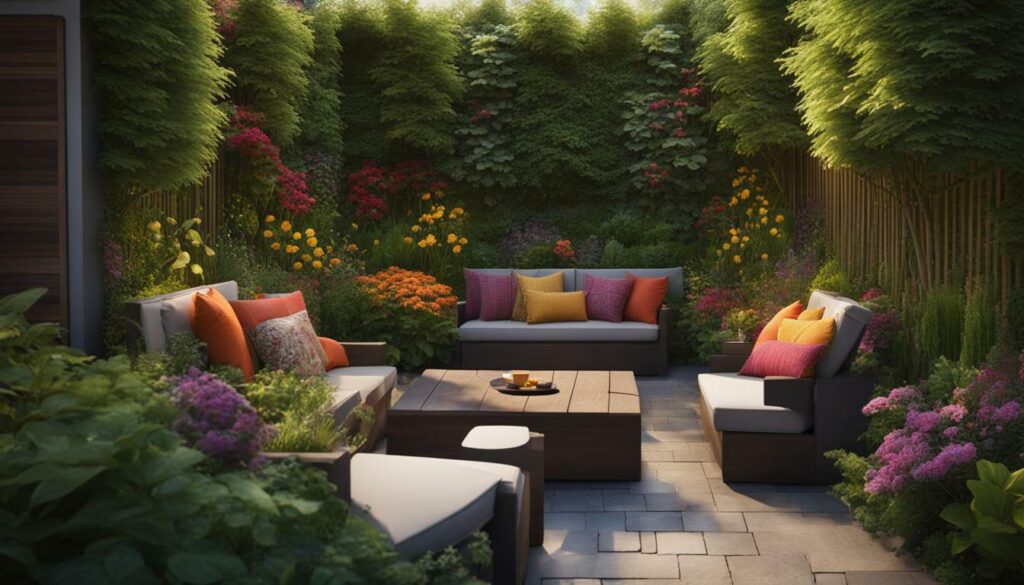
Enhance Your Garden Seating Area:
- Add comfortable cushions to your bench or chairs for a cozy touch.
- Consider incorporating a small table or side tray for holding beverages or reading materials.
- Surround your seating area with hanging baskets or trellises to create a sense of enclosure and privacy.
Incorporating a seating area in your small garden not only provides a space for relaxation but also adds a charming and inviting element to your outdoor space. Take the time to create a cozy corner where you can escape the pressures of daily life and find solace in the beauty of your garden.
Conclusion
Vertical raised garden beds are the perfect solution for maximizing your outdoor space, even if you have limited room to work with. By embracing vertical gardening techniques, mixing up plant varieties, investing in raised beds, and creating focal points and relaxation areas, you can transform your small garden into a thriving oasis.
Vertical gardening allows you to make the most of your garden’s vertical space, utilizing trellises, lattice, and other structures to grow crops vertically. This not only increases your garden’s yield but also improves pest management and makes harvesting easier. Vertical gardening is especially beneficial for small gardens as it reduces the need for sprawling plants that take up valuable horizontal space.
Mixing up the types of plants you grow in your garden can enhance both its aesthetics and functionality. By combining edible and ornamental plants, you can create a visually appealing space while also protecting your crops from pests. This diversity in planting also ensures an optimal yield at harvest time.
Investing in raised beds is a smart choice for small gardens. Raised beds provide better soil control, protect your crops from disease and pests, and allow for efficient use of space. By planting closely together, you can further maximize the use of your raised beds.
Thinking multipurpose is key to making the most of your limited space. Utilize hanging bins, benches with extra storage, and dual-functioning patio furniture to maximize storage and functionality in your small garden.
Adding a focal point to your small garden not only enhances its visual appeal but also creates a sense of purpose and design cohesion. Choose compact items like decorative water features, clusters of ornamental plants, or hardscapes to serve as your garden’s focal point.
A small seating area in your garden provides a space for relaxation and enjoyment. Choose the right seating and surround it with aromatic plants to create a soothing atmosphere. Incorporating a seating area adds an element of comfort to your garden, no matter how small.
In conclusion, vertical raised garden beds offer practical gardening solutions for small spaces. By implementing the tips and techniques mentioned above, you can maximize your space, increase yield, and create a beautiful and functional garden in even the smallest of areas.
What are the benefits of using a vertical raised garden bed for maximizing space and optimizing gardening efficiency?
When it comes to gardening, the best way to optimize green thumb with a vertical raised garden bed. These types of beds are perfect for maximizing space and ensuring gardening efficiency. They allow you to grow more plants in a smaller area and make it easier to tend to your garden without strain.
FAQ
Q: What are the benefits of vertical raised garden beds?
A: Vertical raised garden beds maximize space and increase yield in gardens. They provide better control over soil quality, protect crops from disease and pests, and allow for efficient use of outdoor space.
Q: How do I start small in gardening?
A: Starting small in gardening is important, especially for beginners. Begin with a few native plants or easy-to-grow crops. Native plants are better adapted to the local climate and are easier to maintain. Starting small also helps avoid overwhelming yourself and wasting resources on the wrong plants.
Q: What crops are suitable for small gardens?
A: In small gardens, it’s best to choose high yield crops that don’t require much space. Carrots, garlic, lettuce, radishes, spinach, and vertically growing crops like tomatoes, cucumbers, and beans are great options for small gardens.
Q: What is vertical gardening?
A: Vertical gardening is a technique that maximizes growing space by utilizing upright growth habits or containers. It involves growing crops vertically on trellises, walls, or other structures. Vertical gardening provides optimal yield, better pest management, and easier harvesting.
Q: Can I mix edible and ornamental plants in a small garden?
A: Yes, mixing edible and ornamental plants in a small garden has several advantages. It enhances the look of the outdoor space, protects the crops from pests, and attracts pest-eating predators. Planting flowering plants near fruit-bearing plants ensures an optimal yield during harvest time.
Q: Why should I invest in raised beds for my small garden?
A: Raised beds offer several benefits for small gardens. They provide better control over soil quality, protect crops from disease and infestations, and make gardening easier by confining plants to a small space. Raised beds also allow for the planting of crops closely together, maximizing the use of space.
Q: How can I make the most out of limited garden space?
A: To maximize limited garden space, consider investing in multipurpose gardening items such as hanging bins, benches with extra storage, and patio furniture that can also serve as planters. These items help make every square inch of space work harder.
Q: Why is it important to add a focal point in a small garden?
A: Adding a focal point in a small garden enhances its visual appeal and creates a sense of purpose. It helps bring all the design elements together and makes the outdoor setup cohesive. Compact items like decorative water features, plant clusters, or garden benches can be used as focal points.
Q: How do I create a relaxing space in a small garden?
A: Save a little space in your garden for relaxation by adding a simple seating area. Choose a rustic bench or compact patio chairs and surround the area with aromatic herbs, flowering plants, or trailing plants to create an intimate, soothing space. Add textures, colors, and pretty paving to give the space visual interest.
Q: What are the advantages of vertical raised garden beds in small spaces?
A: Vertical raised garden beds are ideal for maximizing space in small gardens. They provide better soil control, increase yield, protect crops from disease and pests, and allow for efficient use of limited outdoor space.

